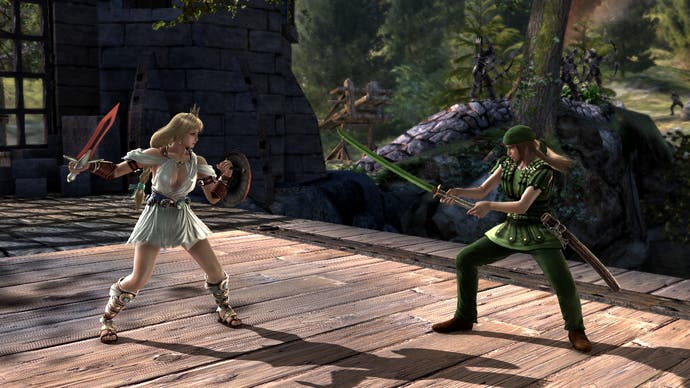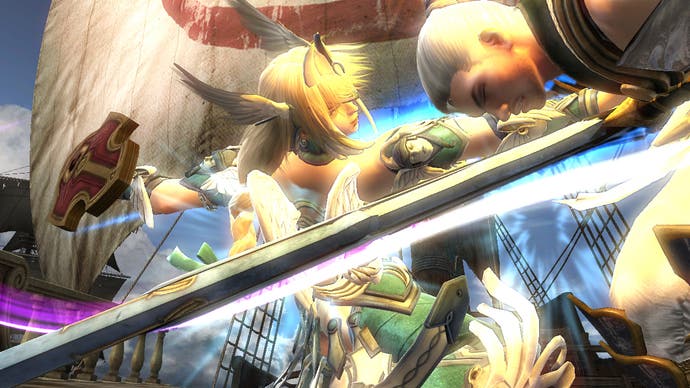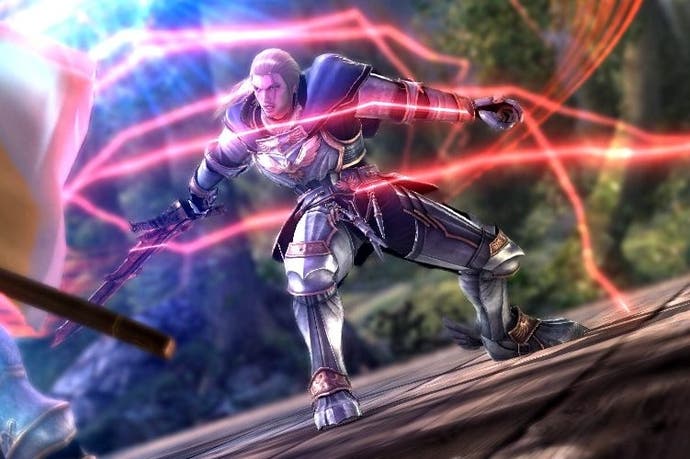Soul Calibur: Lost Swords review
The waiting game.
They say that patience is a virtue, but when you apply this logic to installation times and online video buffering, it's fair to say that waiting isn't something we embrace with open arms. It's why PC enthusiasts buy solid-state drives. They offer significantly smaller storage capacity, but if you feel the same way about loading screens as most people do about commercial breaks and doctor's waiting rooms, then there's no better way to enjoy a game while keeping the interruptions to a minimum.
This principle is something that Soul Calibur: Lost Swords completely fails to appreciate. It's a free-to-play fighting game that takes the foundation of Soul Calibur 5 and refashions it into a single-player experience. On the face of it, this doesn't sound like a bad idea; despite a notable misstep in the form of Soul Calibur Legends, the Soul series (especially the earlier games) has had a respectable history when it comes to solo questing. But, far from rekindling the classic modes of yore, Lost Swords turns the art of sword-collecting and AI-walloping into a disappointingly mindless experience.
The first clue that this game is a barebones cash-in comes courtesy of the fighting system. In terms of core mechanics, everything from the eight-way movement to the horizontal and vertical slashes is exactly where it should be, and while some players will be disappointed by the absence of ring-outs - especially given the complete lack of multiplayer - there's enough of the old Calibur magic beating under the armour to bust out a few time-honoured combos. It's a shame, then, that the new mechanics are geared more towards monetisation than enhancing the combat.

When you first start the game, you're given a choice of just three familiar faces. There's Siegfried with his hefty Zweihänder, Mitsurugi with his trusty katana and Sophitia with her classic sword-and-shield combo. If you're after the likes of Kilik, Tira and Voldo, they're nowhere to be seen, but you can unlock the two characters you didn't pick in addition to Taki and Ivy. Battling against the AI also turns up the fighting styles of Raphael, Nightmare, Hilde, Astaroth, Cervantes, Pyrrha, Lizardman and Devil Jin - although their respective move-sets are more condensed than usual.
With your starting character selected, you're then given a brief rundown of the new systems and general focus. In a nutshell, Lost Swords starts you off with nothing more than a basic weapon and your character's underwear. It then tasks you with completing quests to earn gold, better equipment and experience levels. There's also a poorly explained crafting system that lets you temper your equipment with various gems in addition to a new elemental slant to the central swordplay. Water, fire and wind each have a strength and weakness, and by equipping the right weapon for the job, you'll inflict more damage for your trouble.
The only noteworthy thing to say about the elemental system is that it makes Soul Crushing - a technique that breaks an enemy's armour and usually leads to more loot - far easier. But aside from that, its impact is purely numerical. On the flipside, the new Weapon Arts carry a little more weight. Every weapon has one Weapon Art that can be performed once the super gauge is full, and while they lack the flexibility of the Brave Edge system from Soul Calibur 5, they range from run-of-the-mill combo extenders to instant guard crushers.

This all adds up to a combat system that feels noticeably dumbed down - and yet, the most disappointing thing about Lost Swords is the one-dimensional quests. Even as far back as Edge Master Mode on the original Soul Blade, Namco challenged players to beat the AI under special circumstances. One mission would limit you to throws or juggling attacks while another would task you with surviving a fight where chip damage was a more substantial threat. In comparison, the quests in Lost Swords offer no more variety than a gauntlet of goons that gradually escalate in difficulty. Sometimes you'll face three in a row, sometimes you'll face 10, but the variety is limited.
It's also worth mentioning that the quest mode features a few scraps of narrative that revolve around a mercenary group called the "Sparhawk's Wing". Most of it reads like it was copied and pasted from Google Translate, and after a few chapters of rough grammar and general banality, you'll probably stop reading it altogether.
This leaves the Partner system as Lost Swords' only good idea. It lets you choose from three randomly selected characters before a Quest begins. Each one belongs to another online player, and then every time the partner gauge fills up during a fight, you can control them temporarily. It's a bit like having a tag system in a Soul Calibur game, and you can even use it to build tandem assaults where both characters take part in the same combo. Better yet, the Partner system promotes a sense of collaboration despite the single-player focus, and if you discover a character that you want to use again, you can send the creator an ally request. If they accept, you'll be able to use their character once per day in addition to earning FP (Friend Points) that grant access to further loot.
It feels like Namco put barely any thought into making the not-so-micro-transactions justifiable or making the single-player focus feel consistently engaging

Whichever way you slice it, though, the best loot is reserved for the Premium Chests. These will set you back £3.19 for one or a wallet-busting £11.99 fox six. That's a lot of money when you consider that the contents - regardless of their high rank - may or may not be useful to your chosen character. The game also uses an AP (Action Points) system that limits how often you can undertake quests. This isn't such a problem with the Normal quests, as they don't eat into your AP tally too drastically, but if you stay with Lost Swords long enough to attempt the Master quests, you'll either have to wait for your AP to recharge or buy an AP Potion at £1.59 a pop.
If you don't mind a bit of downtime between questing, then it's entirely possible to play Lost Swords without reaching for the credit card. But the thing that turns this game from average to frustrating is the ludicrous loading times. Regardless of whether you want to start a Quest, sell an item or just switch between menus, you have to wait anywhere from five to 20 seconds for the game to make it a reality. Add these breaks up over the course of a few days and you have enough time to play another game - as my new Bejeweled high score will attest.
To call Lost Swords a failed experiment would be an insult to every ambitious game that fell flat on its face. It feels like Namco put barely any thought into making the not-so-micro-transactions justifiable or even making sure that the single-player focus felt consistently engaging. It's still a PlayStation 3 game that can be downloaded free of charge, of course, but you're also free to play another game entirely. As much as I hate to say it, I can't think of a compelling reason why you shouldn't do just that.









